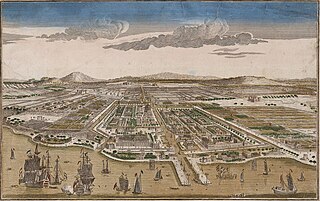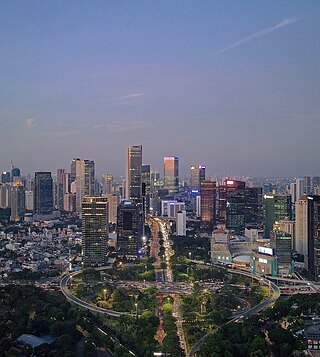
Jakarta, officially the Special Capital Region of Jakarta and formerly Batavia, is the capital and largest metropolis of Indonesia. Lying on the northwest coast of Java, the world's most populous island, Jakarta is the largest metropole in Southeast Asia, and serves as the diplomatic capital of ASEAN. Jakarta is bordered by two provinces: West Java to the south and east; and, since 2000, Banten to the west. Its coastline faces the Java Sea to the north, and it shares a maritime border with Lampung to the west. Jakarta's metropolitan area is ASEAN's second largest economy after Singapore.

Prince Diponegoro, also known as Dipanegara, was a Javanese prince who opposed the Dutch colonial rule. The eldest son of the Yogyakarta Sultan Hamengkubuwono III, he played an important role in the Java War between 1825 and 1830. After his defeat and capture, he was exiled to Makassar, where he died, at 69 years old.

The National Monument is a 132 m (433 ft) obelisk in the centre of Merdeka Square, Central Jakarta. It is the national monument of the Republic of Indonesia, built to commemorate the struggle for Indonesian independence.

Magelang is one of six cities in Central Java Province of Indonesia that are administratively independent of the regencies in which they lie geographically. Each of these cities is governed by a mayor rather than a bupati. Magelang city covers an area of 18.54 km2 and has a population of 118,227 at the 2010 census and 121,526 at the 2020 census; the official estimate as at mid 2022 was 121,675. It is geographically located in the middle of the Magelang Regency, between Mount Merbabu and Mount Sumbing in the south of the province, and lies 43 km north of Yogyakarta, 15 km north of Mungkid and 75 km south of Semarang, the capital of Central Java.

Raden Saleh Sjarif Boestaman was a pioneering Indonesian Romantic painter of Arab-Javanese ethnicity. He was considered to be the first "modern" artist from Indonesia, and his paintings corresponded with nineteenth-century romanticism which was popular in Europe at the time. He also expressed his cultural roots and inventiveness in his work.

Diponegoro University is a public university located in Semarang, Central Java, Indonesia. It was founded in 1957 as a private university by the Semarang University Foundation, which later in 1960 became public university, and named after Javanese Prince Diponegoro. It is the oldest education corporation in Central Java.

Jakarta is Indonesia's capital and largest city. Located on an estuary of the Ciliwung River, on the northwestern part of Java, the area has long sustained human settlement. Historical evidence from Jakarta dates back to the 4th century CE, when it was a Hindu settlement and port. The city has been sequentially claimed by the Indianized kingdom of Tarumanegara, the Hindu Kingdom of Sunda, the Muslim Sultanate of Banten, and by Dutch, Japanese and Indonesian administrations. The Dutch East Indies built up the area before it was taken during World War II by the Empire of Japan and finally became independent as part of Indonesia.

Peter Carey is a British historian and author who specialises in the modern history of Indonesia, Java in particular, and has also written on East Timor and Myanmar. He was the Laithwaite fellow of Modern History at Trinity College, Oxford, from 1979 to 2008. His major early work concentrated on the history of Diponegoro, the British in Java, 1811–16 and the Java War (1825–30), on which he has published extensively. His biography of Diponegoro, The Power of Prophecy, appeared in 2007, and a succinct version, Destiny; The Life of Prince Diponegoro of Yogyakarta, 1785–1855, was published in 2014. He has conducted research in Lisbon and the United Kingdom amongst the exile East Timorese student community for an oral history of the Indonesian occupation of East Timor, 1975–99, part of which was published in the Cornell University journal Indonesia.

Colonial buildings and structures in Jakarta include those that were constructed during the Dutch colonial period of Indonesia. The period succeeded the earlier period when Jakarta, governed by the Sultanate of Banten, were completely eradicated and replaced with a walled city of Batavia. The dominant styles of the colonial period can be divided into three periods: the Dutch Golden Age, the transitional style period, and Dutch modernism. Dutch colonial architecture in Jakarta is apparent in buildings such as houses or villas, churches, civic buildings, and offices, mostly concentrated in the administrative city of Central Jakarta and West Jakarta.

The Heroes Monument, popularly known as Tugu Tani is a bronze statue and important landmark located in Jakarta, Indonesia. The monument celebrates the heroes of the struggles of the Indonesian nation symbolized by a peasant youth wearing a caping with a rifle on his shoulder, a mother behind him offering him a dish of rice. The caping is a traditional farmer's hat in Indonesia, thus the statue is also referred as the Farmer's Monument.

Jalan M.H. Thamrin or Jalan Thamrin is a major thoroughfare in Jakarta, Indonesia. The road is located at the center of Jakarta, running from the north end of Jalan Jenderal Sudirman at West Flood Canal at the south end to the roundabout near Arjuna Wijaya Statue Jakarta at the north end. Developed in the 1950s, the road was a landmark of post-colonial Indonesia and continues to have a prominent importance in Jakarta.
Sasana Wiratama, also known as Museum Monumen Pangeran Diponegoro is a museum complex in Yogyakarta, Indonesia. The complex consists of a museum and a monument which commemorates the struggle of Prince Diponegoro, an 18th-century Javanese prince and a National Hero.

The Gedung Agung is one of six presidential palaces of Indonesia, it is located in the city of Yogyakarta. The palace complex covers an area of approximately 4.4 hectares. It is located in front of Fort Vredeburg.
Lapangan Banteng is a historic square located in a historic area formerly known as Weltevreden, today Sawah Besar subdistrict, Central Jakarta, Indonesia.

Patung Pemuda Membangun is a statue located at the southern end of Jalan Jenderal Sudirman, Jakarta, Indonesia. The statue marks the entrance to Kebayoran Baru subdistrict in South Jakarta.
The Golden Triangle of Jakarta or can also be referred to as Medan Merdeka–Thamrin–Sudirman Axis or Sudirman–Thamrin–Kuningan Axis, is a roughly triangular area in the center of Jakarta, Indonesia, extending from Central Jakarta to South Jakarta. Most of the city's foreign embassies and tallest skyscrapers are located in the area, which is the main CBD of Jakarta.

Semanggi Interchange or commonly known as Semanggi Bridge is a major road interchange in Jakarta, Indonesia which consists of a cloverleaf interchange —the first, and until the 1990s the only, of its kind in Indonesia—and a partial turbine interchange. Two main roads of the city Gatot Subroto Road and Sudirman Road intersect at this interchange. Initially completed in 1962 as part of several projects intended to be completed before the 1962 Asian Games, the interchange is a landmark and an important part of the Golden Triangle of Jakarta.

Dirgantara Monument, also known as Gatot Kaca Monument after the Javanese wayang figure, is a monument located in Jakarta, Indonesia. It is also known as Tugu Pancoran, after tugu a word for statue and pedestal, and the South Jakarta subdistrict of Pancoran, where it is located. The monument was commissioned by President Sukarno in 1964 as a tribute to the Indonesian Air Force and early Indonesian aviators who flew against the Dutch to achieve independence.

West Irian Liberation Monument is a postwar modernist monument located in Jakarta, Indonesia. It is located in the center of Lapangan Banteng in Sawah Besar, Central Jakarta. Sukarno, then President of Indonesia, commissioned the monument in 1963 following the West New Guinea dispute in which Indonesia received the territory of Western New Guinea from the Netherlands.

Hotel Borobudur is a five star hotel and serviced apartment located in Central Jakarta, Indonesia. Conceived in the 1960s by President Sukarno, it was meant to be the second international-standard hotel to be built in the newly independent country. The hotel is located near Lapangan Banteng, which during the colonial times was the center of what was the military-European colonial neighborhood of Weltevreden. At its opening in 1974, as the Hotel Borobudur Inter-Continental, it was the largest hotel in Jakarta.

















